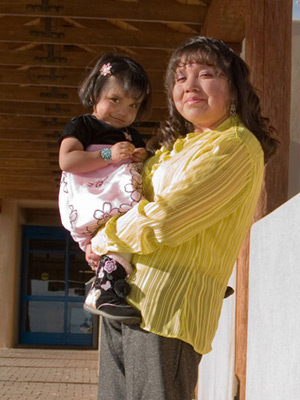
EARLY CHILDHOOD: Child Development/Mental Health
SECTIONS: Build healthy emotions ~ Build language skills ~ Build healthy relationships with brothers and sisters ~ Making playtime safe and fun ~ Limit TV time ~ Create a quiet bedtime routine ~ Learning to use the potty
 Build healthy emotions
Build healthy emotions
- Show affection through hugs, smiles, and encouraging words in ways that are comfortable for your family and culture.
- Let your child practice making choices. "Do you want to wear a green shirt or a blue shirt today?" (Too many choices make it hard for a child to decide.)
- Help your child learn to explain feelings by using words that describe them: "I know you are really sad that we have to leave the park now."
- Help your child learn to recognize others' feelings. "Look how excited Grandma is to see you! Let's go say 'hi!'"
- Teach your child to say "I'm sorry" and "I made a mistake" by example.
Build language skills
- Help your child learn to love books by reading every day. Talk about the pictures. Ask "what happens next?" Let her pick the book, even if it is the same book you read last night and the night before.
- Your child is learning new words every day. Read books or look at magazine pictures, and sing songs. Talk about things you do together.
- Describe your child's actions: "You are pointing to apples. Do you want to eat one?"
- Give your child plenty of time to respond to your questions. Repeat what he says so he knows you are listening.
- If your family speaks two languages, your toddler will be learning both.
Build healthy relationships with brothers and sisters
- If you are expecting a new baby, help prepare your child by reading books about a family with a new baby, big brothers, and sisters.
- Your child may stop using the potty or return to other younger behaviors when the new baby comes. Try not to make demands on her during this time.
- Help your children develop good relationships with each other. Acknowledge conflicts, and try to resolve them without taking sides.
- Encourage good behavior through guidance and discipline.
- Praise your child's positive behaviors and accomplishments. Catch him being good!
- Reduce the number of times you must say "no!" Make your home child-friendly. Create more "yes" times and save "no" for when you really mean it.
- Decide as a family what rules are appropriate, and try to follow them. Even if your child is too young to remember all the rules, keep reminding him what is expected.
- Plan what to do if your child doesn't always follow your rules. You might simply stop play, distract her, or use a brief time-out to let her calm down.
- Help your child learn to use words instead of hurtful actions, like yelling, hitting, or biting. Express your feelings, and provide a place for him to calm down, or give your child a soft ball to throw to get rid of bad feelings.
Making playtime safe and fun
- Children learn from talking, playing, and working with others. Talk with your health care provider about the different kinds of play groups or preschools. Your community may have fun, safe activities for young children: Boys and Girls clubs, a YMCA, and others.
- Offer encouragement as your child tries new things, investigates interesting toys, and builds on growing abilities.
- Encourage your child to play alone as well as with playmates, siblings, and parents. This will help him learn to explore toys and activities on his own.
- Make sure your child's toys are safe. Remember that "toys" don't have to come from a toy store. Pots, pans, spoons, and boxes are favorite toddler toys.
- Join your child in make-believe play with dolls, toy animals, etc.
- Help your child learn to share and take turns.
Limit TV time
- Limit screen time (television, videos, video games, computers) to an hour or less a day. No screen time is recommended for children younger than 2.
- Watch educational programs with your child and talk about them.
Create a quiet bedtime routine
- Help your child wind down at night with familiar routines. Bathing, brushing teeth, reading a book, and talking about the day can be part of a secure routine. Try to put your child to bed at the same time each night. Tuck him in when he is drowsy, but still awake to help him learn to fall asleep on his own.
- At this age it is normal for children to wake at night. Calm reassurance from you, combined with a gentle back rub, may help him return to sleep.
